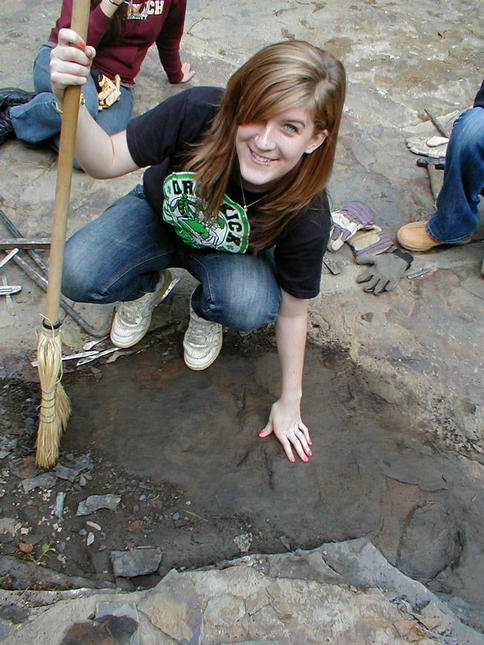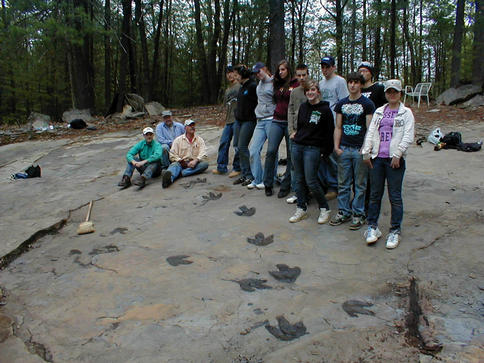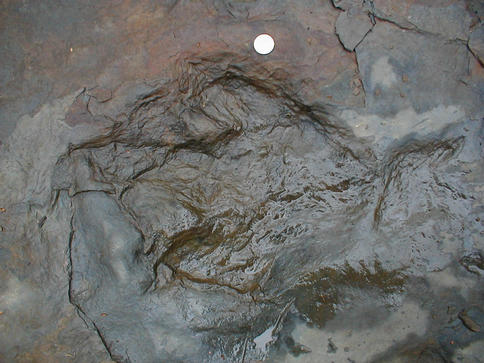
Hannah Pratt, a senior at Windham Christian Academy, uses a broom to sweep away debris from one of the discovered dinosaur footprints.
June 7, 2009

Hannah Pratt, a senior at Windham Christian Academy, uses a broom to sweep away debris from one of the discovered dinosaur footprints.

The Windham Christian Academy crew looks at its discoveries. They are, from left, sitting: teacher Dave Earle, the Rev. Paul Veit and Roy Mickelson; and, standing, Hsing-Sheng “Sean” Yang, Jona-Lynn Hagerstrom, Sarah Howe, Liz Trefethen, Connor Briggs, Hannah Pratt, Christian Briggs, Derek Hayes and Ji Sen Yoon.

This is a close-up of one of the dinosaur footprints discovered by Windham Christian Academy students in Massachusetts. Photos courtesy Dave Earle
Students at Windham Christian Academy recently had the thrill of a lifetime after uncovering dinosaur tracks at quarry in Granby, Mass.
A group of seven students and three foreign exchange students worked together to chisel and move a slab of stone, one measuring 6 feet long and 5 feet wide. Underneath it, they discovered a single footprint thought to be from a meat-eating carnivore measuring 15 feet long. The dinosaur thought to have made the huge footprint was a Dilophosaurus.
“My heart was pumping,” said Dave Earle, a math and computer teacher who organized the field trip. “It was awesome. This is something I have wanted to do since I was a kid. I don’t think all the kids truly understood how unique this experience was. Oh, man I’d like to do that again.”
It took Earle two years to secure the field trip with the Dinosaur Encounter of Bridgton. Students spent a day and a half excavating a site in the Connecticut River valley.
The process to excavate the footprints is tedious. Earle said they used a tool similar to a butter knife to split the slate beds. When the slate begins to crack, you search for the next layer and spread the knives around the slab to even out the pressure, he said.
“You don’t want to crack the slabs or you would ruin the footprint,” Earle said.
“The students did really well. They worked hard and stayed with it. When they picked up the slabs and found a footprint, they were excited. I think many of them were surprised.”
One of those students is Jona-Lynn Hagerstrom, 17, who said they learned two different views on how the rock area was formed with the fossils in it. She said one view suggests that each rock layer represents a different time period. Another belief suggests the rocks were formed in a great cataclysmic flood in the Old Testament.
“It was a really exciting feeling. Dinosaurs had actually walked where we were standing,” Hagerstrom said. “It was so much fun. It was so cool.
“Some of the footprints were so defined you could feel the bumpiness on the bottom of the dinosaur’s feet. Some were so good you could see all the wrinkles.”
The students uncovered roughly six large footprints measuring about 14 inches long. They also uncovered several footprints that were 2 to 3 inches long, most likely coming from a dinosaur that measured 3 to 5 feet tall.
“It was pretty awesome,” said Connor Briggs, a junior at the academy. “Not many people would have the chance to touch a dinosaur footprint or even find one. They are more common than people think.”
Sarah Howe, 17, said it was incredible to see the evidence that dinosaurs existed.
“It was awesome. We had so much fun digging up these enormous tracks,” Howe said. “It was really awesome to be close to my classmates and work together as a team to uncover these amazing footprints.”
Source. Close to Home: Dinosaur discoveries – Students from Windham Christian Academy unearth prehistoric footprints during a Massachusetts field trip,” by Melanie Creamer, Staff Writer, Portland Press Herald, June 3, 2009.
About Loren Coleman
Loren Coleman is one of the world’s leading cryptozoologists, some say “the” leading living cryptozoologist. Certainly, he is acknowledged as the current living American researcher and writer who has most popularized cryptozoology in the late 20th and early 21st centuries.
Starting his fieldwork and investigations in 1960, after traveling and trekking extensively in pursuit of cryptozoological mysteries, Coleman began writing to share his experiences in 1969. An honorary member of Ivan T. Sanderson’s Society for the Investigation of the Unexplained in the 1970s, Coleman has been bestowed with similar honorary memberships of the North Idaho College Cryptozoology Club in 1983, and in subsequent years, that of the British Columbia Scientific Cryptozoology Club, CryptoSafari International, and other international organizations. He was also a Life Member and Benefactor of the International Society of Cryptozoology (now-defunct).
Loren Coleman’s daily blog, as a member of the Cryptomundo Team, served as an ongoing avenue of communication for the ever-growing body of cryptozoo news from 2005 through 2013. He returned as an infrequent contributor beginning Halloween week of 2015.
Coleman is the founder in 2003, and current director of the International Cryptozoology Museum in Portland, Maine.
Filed under Cryptotourism, CryptoZoo News, Fossil Finds